“
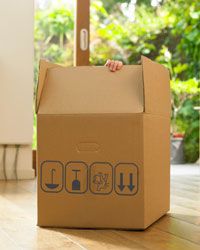 “This is more than a box. Can’t think of any way to reuse it? We’ve got 10!Michael Blann/Getty Images
“This is more than a box. Can’t think of any way to reuse it? We’ve got 10!Michael Blann/Getty Images
Chances are high that many of the staples currently lying around your house or office are or were once packaged in cardboard. Consumer goods like toothpaste, cereal and snack foods almost always come nestled inside a type of cardboard called paperboard. Pressed flat and coated to lend a more aesthetically pleasing appearance, paperboard is a high-class version of corrugated cardboard, which is commonly used for shipping purposes. In fact, cardboard boxes are the packaging material of choice for 90 percent of products shipped in the United States [source: Earth911]. Because of cardboard’ s dominating presence in the world’s packaging and delivery sectors, cardboard boxes comprise a whopping 9 percent of the refuse in a typical landfill [source: Journey to Forever].
But cardboard doesn’t lose its usefulness once the snacks are gone and packages have been opened. Aside from simply recycling cardboard, you can use the material in dozens of creative and practical ways. HowStuffWorks has compiled a list of 10 uses for old cardboard that children, adults and even rodents will appreciate.
Contents
- Playhouses
- Storage
- Checking for Leaks
- Gardening
- Checking for Choking Hazards
- Makeshift Sled
- Crafts
- Temporary Roof Repair
- Pet Toys
- Surface Protector
10: Playhouses
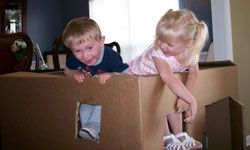 “
“ “It may look like fodder for the recycling bin, but this box is actually a magical castle.Photo courtesy Alia Hoyt
“It may look like fodder for the recycling bin, but this box is actually a magical castle.Photo courtesy Alia Hoyt
Many children today have more toys than they know what to do with. Despite an abundance of interactive and electronic toys, a simple cardboard box is often all it takes to ignite a firestorm of imaginative play. A few windows or doors (cut into a square or rectangular box with an adult’s help) transform an otherwise would-be piece of trash into a playhouse with limitless possibilities. This is one toy that offers a smorgasbord of opportunities for playtime, rather than limiting its user to a few battery-powered functions. Kids can decorate their playhouse box or leave it plain. Either way, it’s sure to offer hours of entertainment, particularly on those days that are too rainy, cold or hot to venture outside.
Canada has taken the cardboard house idea to the next level. Recycled cardboard is now used as the main building material in temporary emergency housing camps. Some enthusiasts of these cardboard cribs are hoping that the material will eventually become a staple of residential development [source: Journey to Forever].
9: Storage
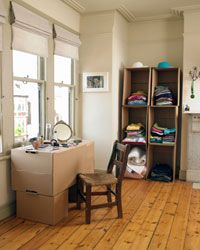 “
“ “No closets? No problem. Cardboard offers a variety of storage solutions.Michael Blann/Getty Images
“No closets? No problem. Cardboard offers a variety of storage solutions.Michael Blann/Getty Images
Storage is one of the more obvious ways to reuse cardboard. After all, who doesn’t have a box of old invoices, pay stubs and bank statements lying around the house? Cardboard offers many more inspired and useful storage opportunities for seasonal, day-to-day and other purposes.
For example, holiday lights can be twisted around cardboard wrapping paper tubes to prevent annoying tangles. Electrical cords, yarn, string and pretty much anything else that may get tangled up can be stored this way, too. Empty liquor boxes with dividers offer a safe place to nestle delicate ornaments, crystal, light bulbs or other breakables. Handymen may use those same liquor boxes to conveniently separate household hardware, including nuts, bolts, nails and dowels.
And if you thought the only thing a paper towel tube was good for was a makeshift megaphone, think again. These cardboard tubes are ideal for keeping important documents like marriage licenses, bills or children’s artwork wrinkle-free.
8: Checking for Leaks
 “
“ “The house is gorgeous, sure, but how about that pristine paved driveway? Keep your carport clean by putting cardboard under leaky cars.Ivan Hunter/Getty Images
“The house is gorgeous, sure, but how about that pristine paved driveway? Keep your carport clean by putting cardboard under leaky cars.Ivan Hunter/Getty Images
Anyone who has ever tried to remove an oil spot from a driveway or garage floor knows that it’s a good idea to figure out where an auto leak is coming from and what it is before it gets out of control. In addition to creating unsightly messes, leaking fluids can be a sign of a car in need of repair. Many automotive experts recommend using a large piece of cardboard (preferably white, but any type will do in a pinch) to identify the source of the leak.
Simply slide the cardboard under the car and check it the next morning for the color and texture of the spots. Engine oil will be oily and black, whereas brake fluid is oily and clear. Coolant leaks are usually green or yellow, and transmission fluid is typically red in color [source: Warranty Info]. It makes your mechanic’s job considerably easier if you provide these types of details instead of just complaining vaguely of "some type of leak, coming from somewhere in the car."
7: Gardening
People with green thumbs tend to be all-around green, often seizing opportunities to reuse everyday products in Earth-friendly ways. Cardboard is a favorite among gardeners for a variety of purposes. Some use pieces of flat cardboard to kneel on during grueling hours of weed-pulling and seed-planting.
Another gardening use for cardboard is sheet mulching, which is done to block and kill weeds and insulate plants during the frigid winter months. Gardeners recommend obtaining large pieces of cardboard and then laying them down on top of existing soil and weeds. Overlap the edges to keep the sun from penetrating through. The cardboard blocks sunlight from the weeds, preventing them from growing. You can also cut pieces of cardboard to fit around existing shrubs and plants, providing insulation to delicate greenery in the cold weather. Simply cover the cardboard with a couple of inches of mulch, wood chips or leaf litter and wait until spring. Over time, the cardboard will decompose and enhance the soil. Garden-friendly earthworms also appreciate the warmth the cardboard provides [source: San Francisco Gate]. Even weed and grass-filled flowerbeds can be turned into lovely plots of flowers using this time-tested method of gardening.
6: Checking for Choking Hazards
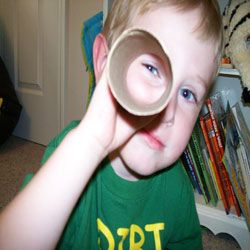 “
“ “This toilet paper roll could save your child’s life.Photo courtesy Alia Hoyt
“This toilet paper roll could save your child’s life.Photo courtesy Alia Hoyt
Most parents don’t put a price on their children’s safety, which is why high-quality car seats, helmets and childproofing devices practically fly off the shelves. One safety device that doesn’t cost a penny — and is abundant in all homes with indoor plumbing — is the cardboard tube that you find at the end of a roll of toilet paper.
Safe Kids Worldwide recommends that parents of small children use the standard 1.5-inch (3.81-centimeter) tube to determine whether a toy or object is too small for a baby or toddler to play with. If an object can fit through the tube, it can fit down a child’s throat — posing a serious choking risk.
When in doubt, parents or caregivers can use a toilet paper tube to determine if something is hazardous to a child who doesn’t know any better than to put it in his or her mouth. It’s a simple way to reuse cardboard and to potentially avert disaster.
5: Makeshift Sled
 “
“ “Competitors in the 18th annual Mount Sunapee Intragalactic Cardboard Sled RacePhoto courtesy Mt. Sunapee and Ross Malaguti
“Competitors in the 18th annual Mount Sunapee Intragalactic Cardboard Sled RacePhoto courtesy Mt. Sunapee and Ross Malaguti
Other than hot chocolate and some cold-weather gear, a little bit of cardboard is all it takes to enjoy a snow day. Rather than drop big bucks on a designer snow sled, kids (and adults for that matter) can enjoy a ride down a snowy hill inside a cardboard box. If you’ve got lots of cardboard and some ingenuity, you can make a fleet of sleds for the whole neighborhood!
Some people take it a step further by designing and decorating cardboard sleds. Still others have turned it into an all-out sport. Events such as the Telluride Cardboard Sled Derby and the Mount Sunapee Intragalactic Cardboard Sled Race challenge entrants to design, build and race in cardboard sleds built with only the basics. The Mount Sunapee race, for example, limits building materials to cardboard, wax, tape and paint — zero hardware permitted. And as you can see from the picture on the right, contestants get pretty creative.
4: Crafts
Crafty people seem to be able to make works of art out of other people’s trash with little or no effort. If you need some ideas or directions, hundreds of Web sites detail thousands of homemade art possibilities, and many of these projects list cardboard as one of the primary building materials. Family Fun provides directions on building superstructures such as cardboard barns, skyscrapers and the like. Other rainy-day ideas include cardboard costumes (such as chicken and washing machine designs), sandals, spy periscopes, guitars and more. You can find plenty of Web sites that offer instructions on building cardboard trucks, trains, robots and TV sets. The only supplies you’ll need are plenty of cardboard and some everyday items you’re bound to have lying around the house.
3: Temporary Roof Repair
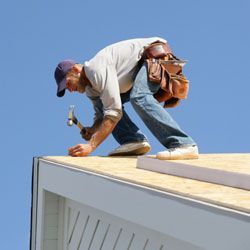 “
“ “Until a professional can repair your roof, cardboard can keep leaks at bay.Steven Puetzer/Getty Images
“Until a professional can repair your roof, cardboard can keep leaks at bay.Steven Puetzer/Getty Images
When violent thunderstorms or severe weather move through your town, nerves aren’t the only thing wind and rain can rattle. Often, homes sustain minor damage from these systems, and your roof is particularly susceptible to the effects of wet weather.
You can use cardboard to temporarily patch rooftop holes, buying some time until a professional is able to repair the problem. Simply place some cardboard inside a plastic bag, and then put it under the shingles [source: Readers Digest]. Your makeshift cardboard patch won’t hold out forever, but it helps keep a home dry in a pinch.
Any leftover cardboard from your patching project can be reused to make a playhouse (see idea No. 1). This’ll keep your kids occupied until the severe weather system moves from the area and your soggy yard dries up.
2: Pet Toys
Hamsters, gerbils and other small rodent pets are easily and cheaply entertained. A cardboard tube or two placed inside a cage provides endless entertainment for furry friends who enjoy running through tunnels. As an added bonus, the tubes also double as chew toys!
Larger animals, such as rabbits, reap the same joy out of cardboard boxes with a couple of holes cut in the side. This concept can even be taken a step further by attaching multiple boxes and cardboard tubes to create an elaborate pet playhouse. Downloadable cardboard cat toy templates are also available on the Web and include instructions on how to make a cardboard mouse or ball that Fluffy will enjoy chasing for hours [source: Marmalade Pet Care].
1: Surface Protector
 “
“ “This guy could’ve used a cardboard drop cloth.Iain Crockart/Getty Images
“This guy could’ve used a cardboard drop cloth.Iain Crockart/Getty Images
Why drop 10 or 20 bucks on a fabric drop cloth when you’ve got stacks of cardboard in the garage? Cardboard can act as a drop cloth during painting or furniture staining projects. The thickness and texture of corrugated cardboard keep water and other substances from leaking through, making it an ideal surface protector.
Temporary placemats can also be created with just a few rectangular pieces of cardboard and a pretty covering (such as shelf paper or fabric). Virtually any surface can be covered and protected using cardboard. Even if something is spilled on it, the cardboard can still be recycled or used for another purpose. Now that’s thinking green — and smart!
Lots More Information
Related HowStuffWorks Articles
- How Recycled Aluminum Can Crafts Work
- How Recycled Vinyl Record Crafts Work
- How Recycled T-Shirt Crafts Work
- How Recycled Glass Crafts Work
- How Recycled Wrapping Paper Crafts Work
Sources
- "Cardboard Box and Tube Crafts." FamilyFun.com http://familyfun.go.com/arts-and-crafts/buildmodel/specialfeature/cardboard_creations_sf/
- "Cardboard Crafts." My Craft Book. http://www.mycraftbook.com/List.asp?subcategoryID=50
- Casey, Laura. "Sheet Mulching Made (Even More) Simple." Oakland Tribune. Oct. 3, 2008. http://findarticles.com/p/articles/mi_qn4176/is_20081003/ai_n29498032/
- "Check Your Driveway for Car Leaks." Warranty Info. http://www.warrantyinfo.com/2009/03/check-your-driveway-for-car-leaks/
- Derby, A. "Homemade Toys for Pet Rabbits." Associated Content. Feb. 20, 2007. http://www.associatedcontent.com/article/148891/homemade_toys_for_pet_rabbits.html?cat=53
- "Extraordinary Uses for Cardboard Boxes." Readers Digest.com. http://www.rd.com/advice-and-know-how/extraordinary-uses-for-cardboard-boxes/article23777.html
- "Extraordinary Uses for Cardboard Tubes." Readers Digest.com. http://www.rd.com/advice-and-know-how/extraordinary-uses-for-cardboard-tubes/article23778.html
- "Facts About Cardboard." Earth911.com http://earth911.com/paper/cardboard/facts-about-cardboard/
- Lewis, Jaye. "How to Mulch Your Garden for Winter." DoitYourself.com. http://www.doityourself.com/stry/cardboardmulch
- Marmalade Pet Care. Cardboard Mouse Cat Toy. http://www.marmaladepets.com/owners/download_mouse.html
- Mount Sunapee 18th Annual Cardboard Sled Race. http://www.mountsunapee.com/mtsunapeewinter/onthemountain/events/eventdetails/sledrace.asp
- Safe Kids USA. http://www.usa.safekids.org/tier3_cd.cfm?folder_id=301&content_item_id=20970
- Telluride Cardboard Sled Derbyhttp://www.telluridecardboardsledderby.com/
- Van Cleef, Lisa. "Quick, easy non-toxic weed control." San Francisco Gate.com. Feb. 25, 2004.
- "What to do with a cardboard carton." Journey to Forever. http://journeytoforever.org/edu_cardboard.html http://www.sfgate.com/cgi-bin/article.cgi?file=/gate/archive/2004/02/25/greeng.DTL
- "10 Expert Tips for Holiday Storage." Better Homes and Gardens.http://www.bhg.com/holidays/christmas/planning/storage/


